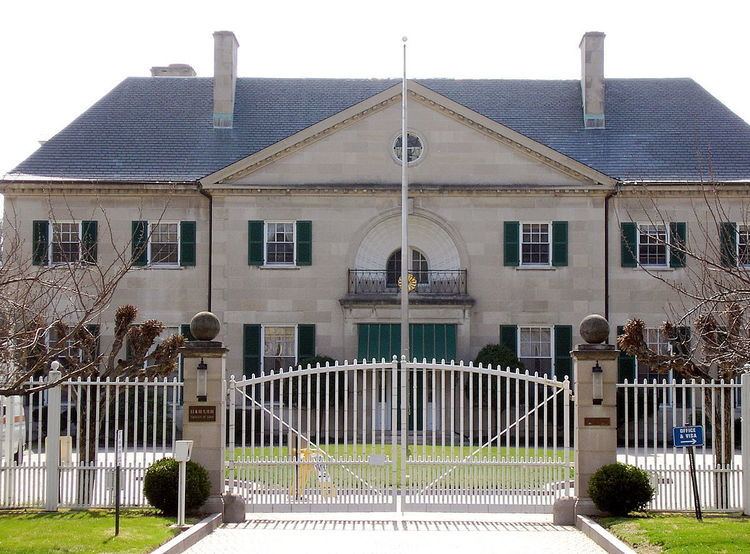Location Washington, D.C. Area 1 ha Phone +1 202-238-6700 | Opened 1931 Ambassador Kenichirō Sasae | |
 | ||
Address 2520 Massachusetts Ave NW, Washington, DC 20008, USA Hours Open today · 9AM–5PMThursday9AM–5PMFriday9AM–5PMSaturdayClosedSundayClosedMonday9AM–5PMTuesday9AM–5PMWednesday9AM–5PM Architectural style Colonial Revival architecture Similar Embassy of Norway in Washingt, Embassy of Brazil - Washingt, Embassy of Indonesia - Washingt, Embassy of Belgium - Washingt, Embassy of Ireland in Washington Profiles | ||
The Embassy of Japan in Washington, D.C. is the diplomatic mission of Japan to the United States. It is located at 2520 Massachusetts Avenue NW, Washington, D.C., in the Embassy Row neighborhood.
Contents
Ambassador
The incumbent Ambassador is Kenichirō Sasae, who presented his credentials in November 2012. Ichirō Fujisaki served as ambassador from 2008 to October 2012.
About the building
The embassy was designed by the U.S. firm of Delano & Aldrich (one of whose principals was William Adams Delano, a distant relative of President Franklin D. Roosevelt). Emperor Hirohito allegedly approved the design personally. The United States Commission of Fine Arts approved the design of the building on September 16, 1930. Erected in 1931, the building is in the Georgian Revival architectural style, with subtle elements of Japanese architecture.
As originally designed, the embassy consisted of the ambassador's residence, two chancery buildings with strong Japanese architectural influence, a tea house, and tennis, gym, and other recreational facilities. The embassy features a cobblestone courtyard and driveway in front of the building. The original embassy building is now known as the Old Ambassador's Residence, and is located at 2516 Massachusetts Avenue NW. The original embassy and the two chancery buildings are two-and-a-half stories in height, with two underground levels. The total building height is about 31 feet (9.4 m). The chancery buildings, which front onto Massachusetts Avenue NW, are about 98 feet (30 m) wide. The grounds were landscaped to complement Rock Creek Park, which abuts the rear of the embassy grounds. As of 1971, the Japanese Embassy was one of the few remaining formal estates in the city. The total cost of construction was $500,000.
In 1959, then-Ambassador Koichiro Asagai and Tatsunosuke Takasaki, a member of the House of Representatives of the National Diet, proposed creating a replica of the rock garden at Ryōan-ji at the Japanese embassy. Constructed to commemorate the 100th anniversary of the first Japanese embassy to the United States, the scaled-down garden was finished in 1960. A small teahouse named Ippakutei (the "Teahouse of 100 Years"), built in the style found at the Katsura Imperial Villa, is in back of the rock garden.
The Japanese Embassy was added to the National Register of Historic Places on February 20, 1973.
Chancery
A stark, Modernist chancery building (the offices of an embassy) was completed in 1986. The chancery was built after Congress passed the Foreign Missions Act in 1982, which made it easier for embassies in the District of Columbia to expand their chanceries. Oddly, the new law significantly delayed construction of the chancery. The federal government lagged in promulgating regulations for the approval of chanceries, which meant that the chancery had to be approved by the District of Columbia Zoning Commission instead. But by the time the matter arose before the Zoning Commission in February 1983, the city was already in a multi-year process to revise its zoning regulations. The delay imperiled the funding provided by the Japanese government for the new building. Under intense pressure from the United States Department of State as well as the Japanese and Saudi Arabian governments (both of which wanted to build new chanceries immediately), the city enacted emergency zoning regulations on April 12, 1983. Construction of the chancery was approved on June 10. It was designed by architect Robert B. Anderson of the Benham Group. The local Advisory Neighborhood Commission and the Sheridan-Kalorama Neighborhood Council applauded the design for "retaining the historical aspects" of the embassy compound. The project consolidated chancery offices from two rented buildings elsewhere in the District into a single structure on the embassy grounds.
The chancery has 250 underground parking spaces, and a tunnel from Waterside Drive lead to the underground parking garage (providing a more secure entry for important diplomats or visitors).
Events
President Barack Obama visited the embassy to express condolences over the 2011 Tōhoku earthquake and tsunami.
